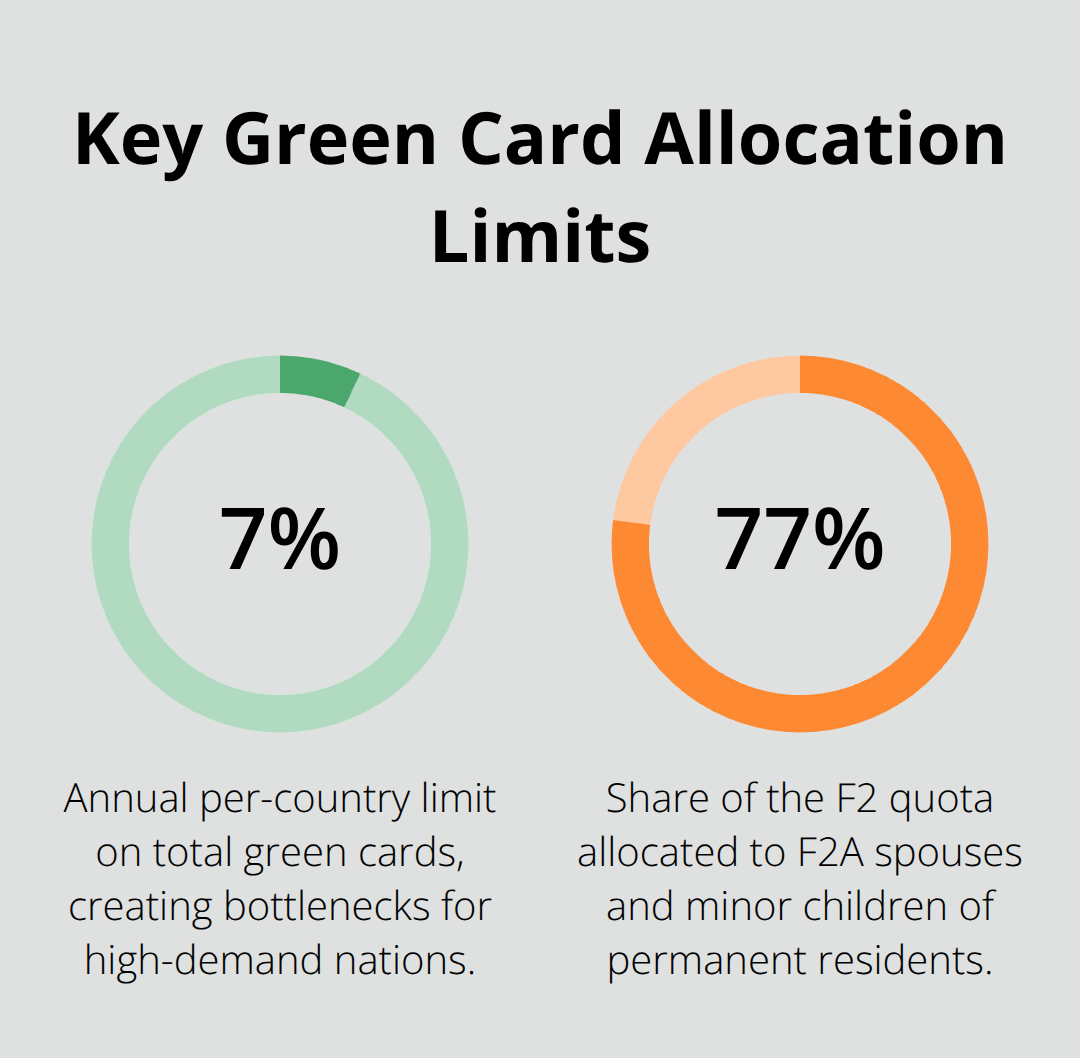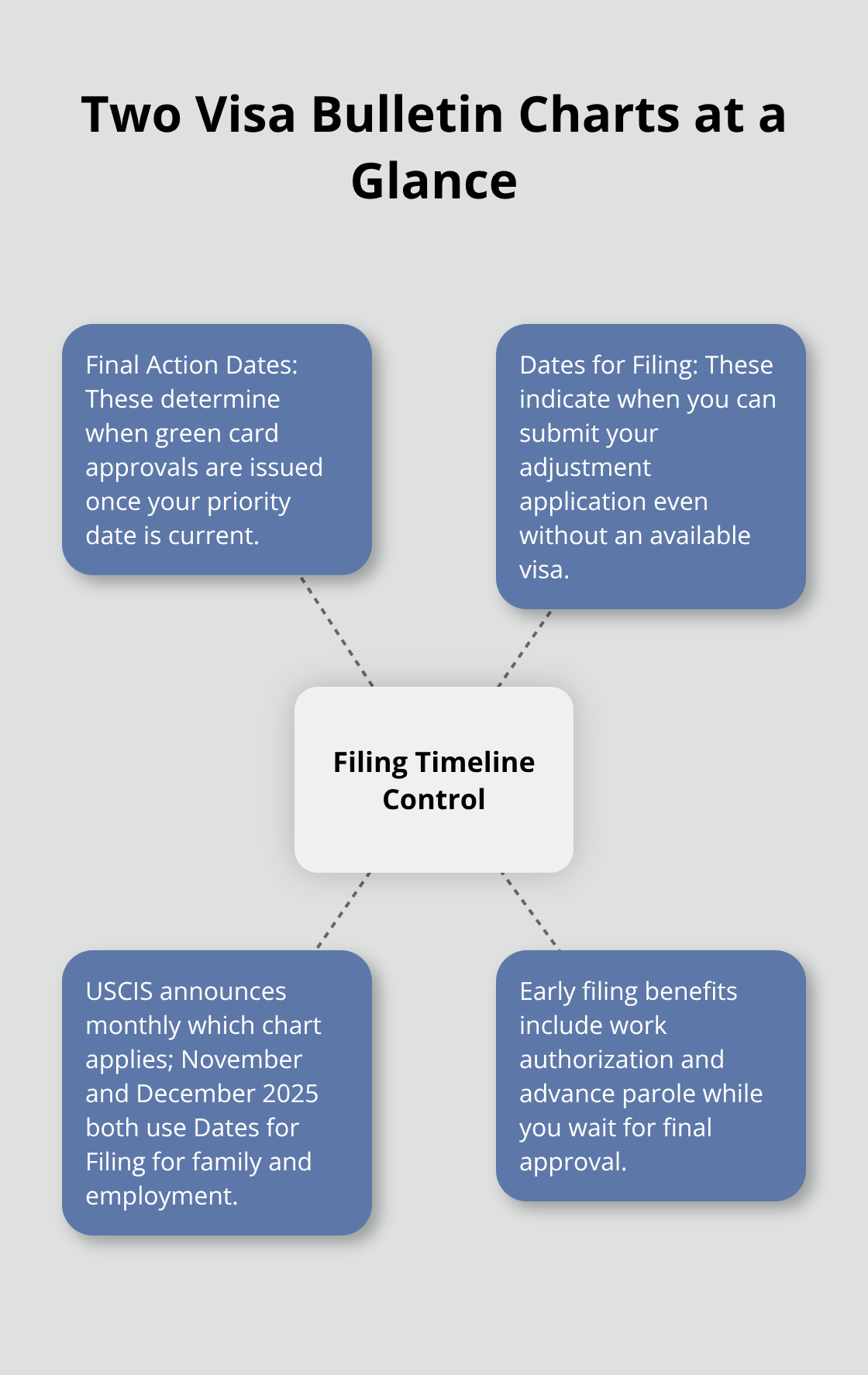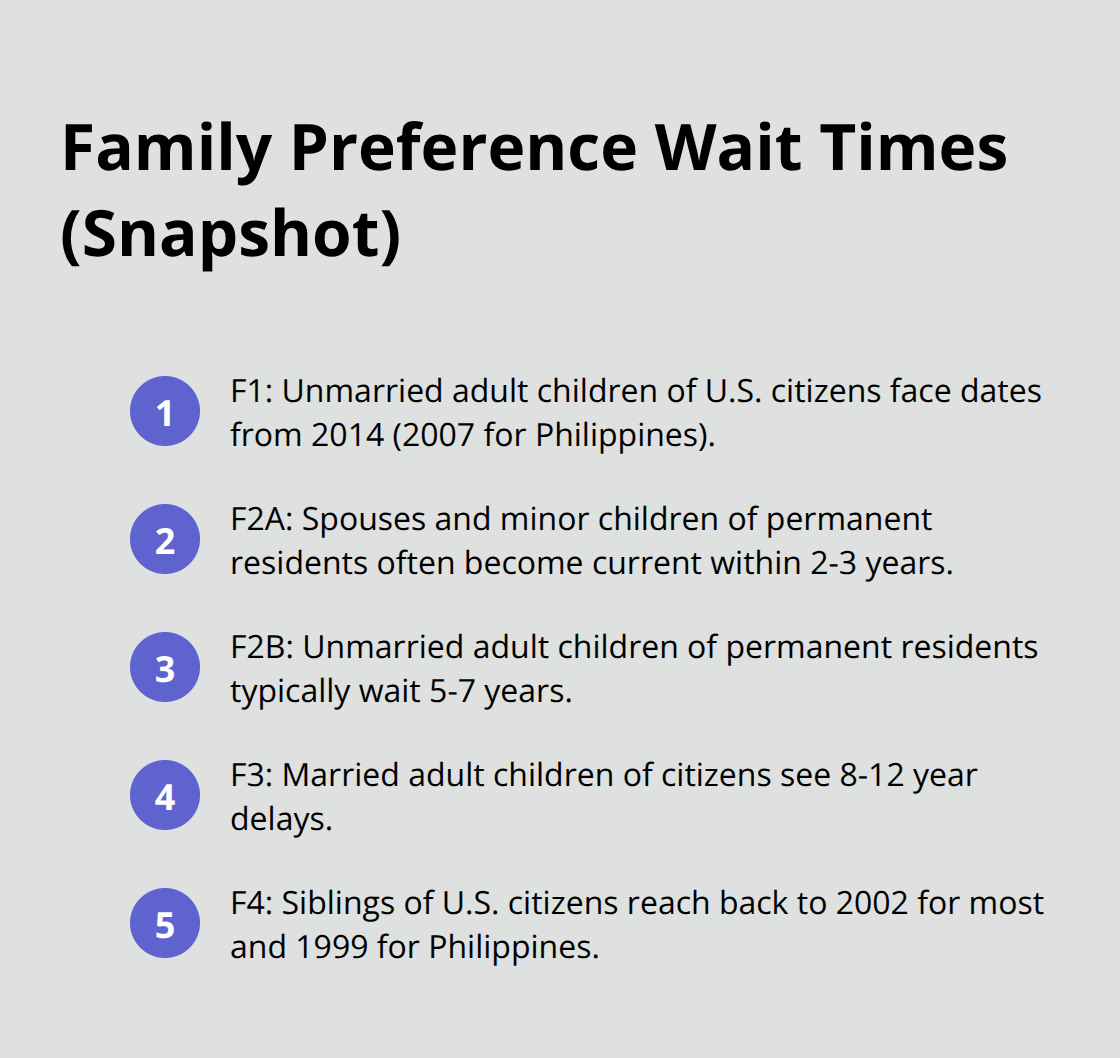
How to Read the Adjustment of Status Bulletin
The Adjustment of Status Bulletin determines when you can file your green card application. This monthly publication from USCIS controls the timing of thousands of immigration cases.
We at Law Offices of Jeffrey A. Thompson see clients struggle with interpreting these complex charts daily. Understanding priority dates and filing windows can mean the difference between moving forward with your case or waiting months longer.
How Does the Visa Bulletin Structure Work
Priority Date Systems Create Your Place in Line
The visa bulletin operates on a first-come, first-served system through priority dates. Your priority date marks when USCIS received your I-130 family petition or when your employer filed your labor certification for employment cases. This date determines your position in the green card queue among the 366,000 annual allocations.
Family-sponsored categories receive 226,000 visas yearly, while employment-based categories get 140,000. The F1 category for unmarried adult children of citizens caps at 23,400 annually. F2A spouses and minor children of permanent residents receive 87,934 visas each year (representing 77% of the total F2 quota of 114,200).

Country Caps Create Massive Backlogs
Each country faces a 7% limit of total green cards issued annually, which creates severe bottlenecks for high-demand nations. China, India, Mexico, and the Philippines consistently hit these caps, which forces applicants from these countries into multi-year waits while other nationalities move faster through the same categories.
Indian nationals in employment-based categories face the longest delays due to overwhelming demand that exceeds the country cap. Mexican applicants dominate family-sponsored categories and create similar backlogs. The visa bulletin separates these four countries into individual columns, which acknowledges their unique processing challenges.
Two Charts Control Your Filing Timeline
The visa bulletin contains two essential charts that determine different actions. Final Action Dates show which priority dates currently receive green card approvals. Dates for Filing indicate when you can submit your adjustment application early, even without an available visa.

USCIS announces monthly which chart applies to your situation. For November 2025, both family and employment categories use the Dates for Filing chart. Starting December 2025, continue to reference the Dates for Filing chart for both categories. Early filing allows you to obtain work and travel permits while you wait for your priority date to become current for final approval.
These structural elements form the foundation for understanding how the bulletin operates, but the specific categories within each section contain the details that directly impact your case timeline.
What Do the Bulletin Categories Mean for Your Case
Family Categories Control Your Wait Time
Family-sponsored preference categories divide into four distinct groups that directly affect your processing timeline. F1 unmarried adult children of U.S. citizens face the longest waits, with current priority dates from 2014 for most countries and 2007 for Philippines nationals. F2A spouses and minor children of permanent residents move fastest among preference categories, often becoming current within 2-3 years.
F2B unmarried adult children of permanent residents typically wait 5-7 years, while F3 married adult children of citizens experience 8-12 year delays. F4 siblings of U.S. citizens endure the most extensive backlogs, with priority dates that reach back to 2002 for most applicants and 1999 for Philippines nationals.

F2A Category Operates Under Special Rules
The F2A category operates under special rules that exempt most applications from per-country limits, which creates shorter wait times compared to other preference categories. However, April 2023 marked the first time in years that F2A became non-current, which signals demand that now exceeds available visas. This shift affects thousands of families who previously enjoyed relatively quick processing times.
Employment Categories Reflect Skill-Based Priorities
Employment-based categories prioritize workers based on education and job requirements, with EB-1 extraordinary ability workers who maintain current status for most countries. EB-2 advanced degree professionals face significant backlogs, particularly Indian nationals who wait 12-15 years under current processing speeds. EB-3 skilled workers experience moderate delays of 2-4 years for most countries, though Indian applicants face 10-15 year waits.
China consistently shows separate priority dates across all employment categories due to sustained high demand that exceeds the 7% country allocation.
Diversity Visa Program Operates Differently
The diversity visa program operates outside preference categories and maintains annual lottery selection of 50,000 winners. Unlike family and employment categories, diversity visas must be used within the fiscal year of selection, which creates strict deadlines for winners to complete their adjustment applications.
Understanding these category distinctions helps you identify your specific timeline, but knowing how to use your priority date effectively requires additional strategic knowledge about when and how to file your adjustment application.
How Do You Find and Track Your Priority Date
Locate Your Priority Date on Official Documents
Your priority date appears on Form I-797 Notice of Action that USCIS issues after it approves your I-130 family petition or I-140 employment petition. Family-based cases use the date USCIS received your I-130 petition, while employment cases typically use either the I-140 date or the earlier labor certification acceptance date from the Department of Labor. Check the top section of your I-797 approval notice where it states Priority Date followed by the specific date in MM/DD/YYYY format.
Employment-based EB-2 cases that required labor certification use the date your employer filed the PERM application with the Department of Labor, not the I-140 date. This distinction can save months or years in your wait time since labor certification often precedes the I-140 petition. Keep both documents accessible since immigration attorneys and USCIS officers frequently request verification of the earliest date that qualifies.
Track Monthly Movement Patterns to Forecast Your Timeline
Priority date movement follows predictable monthly patterns that help forecast your timeline. Family categories typically advance 3-8 weeks per month during stable periods, while employment categories show more volatile movement that ranges from no advancement to 3-month jumps. Indian nationals in EB-2 and EB-3 categories experience the slowest movement, often advance only 1-2 weeks monthly due to overwhelming demand that exceeds the 7% country cap allocation.
Retrogression occurs when priority dates move backward due to unexpected demand surges or administrative changes. The State Department warns of potential retrogression by monitoring application volumes and visa usage rates throughout each fiscal year. F2A experienced its first retrogression in April 2023, moved from current status to February 2022 priority dates within a single month.
Monitor Retrogression Patterns That Affect Your Case
Track these patterns by maintaining a monthly spreadsheet of your category’s movement to identify acceleration or deceleration trends that affect your timeline. Employment categories show more dramatic swings than family categories, particularly for applicants from China and India where demand consistently exceeds supply. The visa bulletin archives provide historical data that reveals seasonal patterns and policy impacts on priority date advancement.
Categories that show consistent monthly advancement of 4-6 weeks typically maintain stable processing, while categories that alternate between large jumps and stagnant periods signal administrative bottlenecks or policy adjustments. We at Law Offices of Jeffrey A. Thompson recommend clients track at least six months of movement data to identify reliable patterns for their specific category and country of birth.
Use Strategic Timing Windows to Maximize Benefits
File your I-485 adjustment application immediately when the Dates for Filing chart shows your priority date as current, even if the Final Action Dates remain behind. This early strategy allows you to obtain employment authorization and advance parole travel documents while you wait for your priority date to reach the Final Action Dates threshold. The work permit typically arrives within 90 days of submission (providing immediate employment flexibility regardless of your current visa status limitations).
Monitor the visa bulletin announcement timing since USCIS typically updates which chart applies within one week after the State Department releases the monthly bulletin. Prepare your I-485 package in advance with medical exams, supporting documents, and filing fees ready for immediate submission when your window opens. Missing an opportunity due to incomplete documentation can cost months when retrogression strikes unexpectedly, particularly in volatile categories like F2A or employment-based preferences for high-demand countries.
Final Thoughts
The Adjustment of Status Bulletin demands consistent attention and strategic preparation to maximize your opportunities. You must track your priority date movement monthly to identify patterns and forecast your timeline accurately. Prepare your I-485 package in advance with medical exams and supporting documents ready for immediate submission when windows open.
The bulletin’s two-chart system creates opportunities for early submission that provide work authorization and travel benefits while you wait for final approval. Missing these windows due to incomplete preparation costs months when retrogression strikes unexpectedly (particularly in volatile categories like F2A or employment-based preferences). Employment categories show more volatile advancement than family categories, especially for applicants from high-demand countries like India and China.
We at Law Offices of Jeffrey A. Thompson help clients navigate complex immigration processes and overcome legal hurdles in their journey toward permanent residency. Our immigration law expertise provides the guidance needed to interpret bulletin changes and maximize your opportunities effectively. Stay proactive with bulletin monitoring, maintain organized documentation, and seek professional guidance when category movements become unpredictable.


